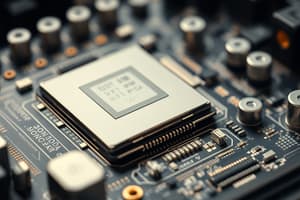Podcast
Questions and Answers
What is the central processing unit (CPU) responsible for in a computer system?
What is the central processing unit (CPU) responsible for in a computer system?
Executing instructions and performing computations
Explain the difference between volatile and non-volatile memory.
Explain the difference between volatile and non-volatile memory.
Volatile memory loses its contents when power is removed, while non-volatile memory retains data even when power is off.
What are some examples of storage devices in a computer system?
What are some examples of storage devices in a computer system?
Hard drives or solid-state drives (SSDs)
How is the CPU composed and what is the function of transistors in it?
How is the CPU composed and what is the function of transistors in it?
What type of memory is Random Access Memory (RAM) and what is its main characteristic?
What type of memory is Random Access Memory (RAM) and what is its main characteristic?
What is the purpose of output devices in a computer system?
What is the purpose of output devices in a computer system?
How do expert systems store knowledge?
How do expert systems store knowledge?
Explain the role of networking equipment in computer technology.
Explain the role of networking equipment in computer technology.
What is the function of inference procedures in expert systems?
What is the function of inference procedures in expert systems?
Describe the user interface of expert systems.
Describe the user interface of expert systems.
Flashcards are hidden until you start studying
Study Notes
Computers: A Deep Dive into Hardware and Expert Systems
Computers have revolutionized our world by enabling rapid and efficient processing of data, automation of tasks, and the development of advanced technologies. This article delves into the intricacies of computer hardware and expert systems, providing a comprehensive understanding of these topics.
Hardware
Hardware refers to the physical components of a computer system, such as the central processing unit (CPU), memory, storage devices, input devices, output devices, and networking equipment. These components work together to execute instructions and perform tasks.
Central Processing Unit (CPU)
The CPU is the brain of the computer, responsible for executing instructions and performing computations. It is made up of millions of transistors, which are tiny switches that can turn on and off at incredibly high speeds. A Pentium® 4 CPU, for example, can execute a billion instructions per second.
Memory
Memory is the storage area where data and instructions are kept for quick access by the CPU. There are two main types of memory: volatile, which loses its contents when power is removed, and non-volatile, which retains data even when power is off. Random Access Memory (RAM) is a volatile memory, while read-only memory (ROM) is a non-volatile memory.
Storage Devices
Storage devices, such as hard drives or solid-state drives (SSDs), provide long-term storage for data and programs. They store information even when the power is off, allowing users to access their files and applications when the computer is turned on.
Input Devices
Input devices, such as keyboards, mice, and touchscreens, allow users to interact with the computer and provide data for processing. They capture and transmit information to the computer.
Output Devices
Output devices, such as monitors, printers, and speakers, display or produce data and information for the user. They receive data from the computer and convert it into a form that users can understand.
Networking Equipment
Networking equipment, such as routers and switches, enable computers to communicate with each other over a network, allowing for the sharing of resources and the transfer of data between devices.
Expert Systems
An expert system is a type of artificial intelligence (AI) that uses knowledge and inference procedures to solve complex problems that typically require a human expert. These systems are designed to mimic the decision-making capabilities of a human expert in a specific domain, such as medicine or engineering.
Knowledge Representation
Expert systems store knowledge in a structured format, such as a rule-based system or a frame-based system. This knowledge is used to make decisions and solve problems.
Inference Procedures
Expert systems use inference procedures to draw conclusions and solve problems. These procedures follow a set of rules to make decisions based on the available knowledge.
User Interface
Expert systems often have a user-friendly interface, allowing users to input data and receive results in a clear and understandable format. This interface may include a natural language processing component, allowing users to interact with the system using everyday language.
In conclusion, both hardware and expert systems play crucial roles in the functioning of computers. Hardware provides the physical components that enable computers to process data and perform tasks, while expert systems utilize AI to solve complex problems and make decisions. Together, these components contribute to the advancement and versatility of computer technology.
Studying That Suits You
Use AI to generate personalized quizzes and flashcards to suit your learning preferences.




